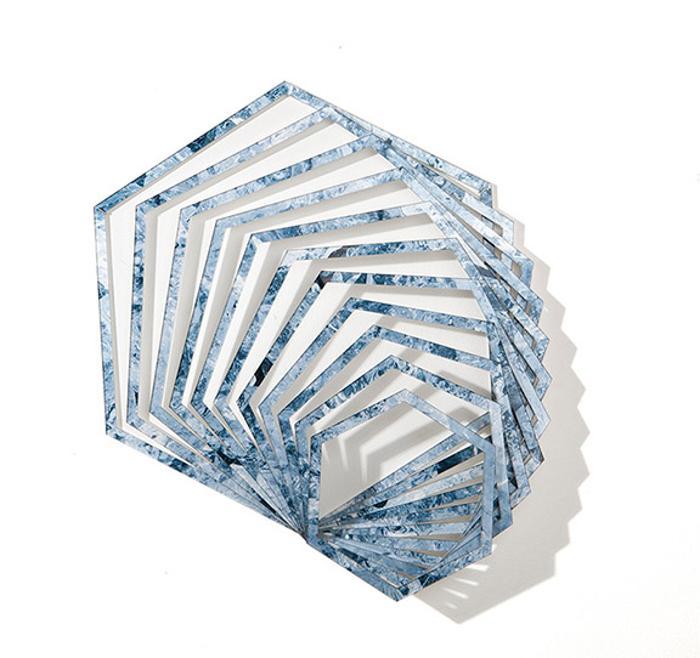The Union College Permanent Collection has a treasure trove of more than 300 historic scientific instruments, including 19th century prisms, a sextant, a sea octant that dates to the College’s founding in 1795, a refractometer and assorted mathematical models.
More than 30 of these instruments are presented in a new light in the Mandeville Gallery exhibit Probability & Uncertainty, in which they are juxtaposed with works by six contemporary artists who focus on scientific themes.
The exhibit runs Jan. 13 through June 17.
The artists are represented by sculptures, paintings, installations and mixed media pieces that incorporate everything from plywood to plasma to Plexiglas.
An opening reception for the show will be held Wednesday, Jan. 24, 5 p.m. - 6:30 p.m. at the gallery’s home in the Nott Memorial.
“The exhibition seeks to emphasize shared impulses found in the humanities and sciences then and now,” said Curator of Art Collections and Exhibitions Julie Lohnes. “Our fields are intertwined metaphorically, and tangibly, within these beautiful objects.”
For example, Lohnes examined the surveying and navigation connections within artist Kirsten Kay Thoen’s explorations of ice flows, geology, river silt and fractals.
The exhibit also presents relationships between the African fractals and algorithms of Nettrice Gaskins’ video installation and French mathematician Théodore Olivier’s geometric models.
Carter Hodgkin’s physics-inspired animations of particle collisions compare with the active colors of the unusually shaped glass tubes by English chemist/physicist William Crookes and German physicist/glassblower Heinrich Geissler.
Artist Jessie Henson’s celestial bodies hark back to orreries of the 1700s-1800s; and both Aimée Berg and Audrey Wilson create fictitious instruments.
Lohnes began delving into the specialized field of historic scientific instrumentation and the lives of the scientists, makers and inventors more than two years ago. After doing extensive research, she saw a natural connection between the show and Union’s plans, announced in March 2017, for a $100 million Integrated Science and Engineering Complex that will fully bring together teaching, learning and research across the liberal arts and engineering.
“With this landmark construction project in the works, this is a perfect opportunity to re-examine the historic scientific instruments held in our Permanent Collection,” Lohnes said.
She selected those that intrigued her visual senses, impressed her with their utility and originality of design, and also commanded a respect for their makers – including Crookes, Geissler, American surveyor William Burt, English instrument maker Michael Butterfield, French inventor Jules Duboscq and German physicist Johann Gottlieb Nörremberg.
Lohnes’ research took her to the National Museum of American History, Smithsonian Institution in Washington, D.C., where she worked with curators from the Division of Medicine and Science; and the collections of Physical Sciences, Mathematics and Electricity.
At Union, she received assistance from many individuals, including Kevin Trigo ’18, who explained classic physics and other topics, which inspired the show’s title; and John Sheehan, Physics and Astronomy Department machinist/technician, who managed the orrery move to the Mandeville Gallery. A mechanical model of a celestial system, the orrery was among the College’s first purchases.
To illuminate the varied aspects of Probability & Uncertainty, a number of campus events have been scheduled this term:
- Olivier Model Demo Day: Assistant Professor of Mathematics Jeff Jauregui will demonstrate the Olivier models on Feb. 8,12:55 p.m. - 1:45 p.m. at the gallery.
- Artist Talk and Reception: Nettrice Gaskins will give a talk April 11, 5:30 p.m., in the Nott Memorial, during a reception, 5 p.m. - 6:30 p.m.
- “Contemporary Art Intersections: Geometry, Optical Illusion & 3D Space”: Gaskins also will offer a maker workshop April 12,12:55 p.m. - 1:45 p.m., at the Feigenbaum Center for Visual Arts (Room 101).
The exhibit and related events are co-sponsored by the departments of Geology, Math, Physics and Astronomy, and Visual Arts; Gender, Sexuality and Women’s Studies; Interdisciplinary Studies; and the Office of Diversity and Inclusion.
Funding was awarded through the Our Shared Humanity’s Mellon grant, which also supported the research trip to the National Museum of American History and the maker workshop event.
Kirsten Kay Thoen, Ice Fractal #1, ed. 3, 2014, digital C-prints on Dur-A-Flex & Plexiglass

Kirsten Kay Thoen, Ice Fractal #1, ed. 3, 2014, digital C-prints on Dur-A-Flex & Plexiglass